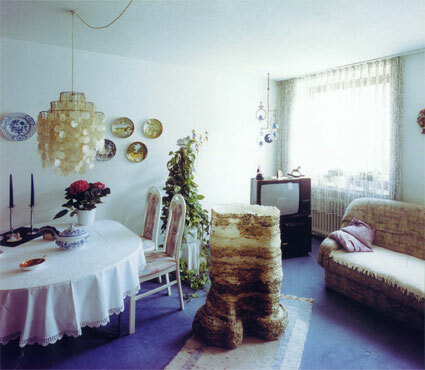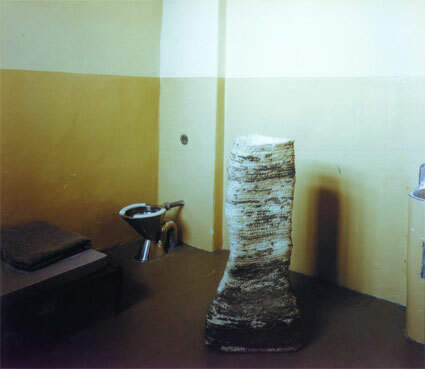Lücke
Amsterdam, Autumn of 1997
It was entirely by chance as most detainees would say that I ended up in the prison. In my case, I came to the Justizvollzugsanstalt für Frauen, in Vechta, Germany, in response to an invitation to exhibit some of my Lücke sculptures there.
The German word Lücke means void, and in this case stands for lack, loss, and absence. The Lücken resemble man-sized wax vase shapes cast in a clay mould. Instead of exhibiting my sculptures, I invited twelve detainees and six guards to collaborate with me on each building their own Lücke. These were photographed by Luuk Kramer in places that were in some way significant to the makers. After this, the Lücke Project toured Germany and the Netherlands and was exhibited in a number of public or semi-public institutions.
The project described above was inspired by a quotation from a letter written by the theologian and philosopher Dietrich Bonhoeffer while he was held captive in Berlin during the Second World War: Widerstand und Haft 1940 - 1945, Heiligabend 1943 (Resistance and imprisonment 1940 - 1945, Christmas Eve 1943) […] nothing is capable of replacing an absent loved one, nor should one seek to find such a replacement; all one can do is to keep going and hold firm; that may initially sound very harsh, but it is in fact a great consolation; for in remaining unfilled, the vacuum sustains the bond.[…]
Ulrike Möntmann

ANDREA BACHMEYER
Size: 90 x 110 x 45 cm
Material: wax.
Location: Mother's apartment, Osnabrück, Germany

BRIGITTE MOSER
Size: 110 x 60 x 60 cm
Material: wax.
Location: Isolation cell, Women's Prison Vechta, Germany

KARIN SCHUMACHER
Size: 60 x 90 x 40 cm
Material: wax.
Location: Sick bay, Women's Prison Vechta, Germany
Voids with a voice: On the exhibition of objects from Ulrike Möntmann’s Lücke project
It is precisely in the greatest extremity that freedom is indispensable. ‘Getting out!’ resounds with new beginnings, of finding oneself in the cold, hard air that generates distance from the stifling heat of the unchangeable. The long penetration of pain has formed a hollow space, a gap, many gaps, so that feelings and ideas become porous. Being torn there worsens the pain and does not transform it into grieving. We humans tolerate pain to a certain degree but must understand that we cope with pain only through grieving.
The void or Lücke left behind by someone or something is a form of grieving. It is a conscious perception of what is lacking. Imprisoned women lack freedom of movement; deprivation of freedom causes pain that envelopes the other, shapes the woman in her cell, impedes her ability to fathom the motives for her actions and prevents the future from approaching her in her entirety, surrounding her and enabling her to live on the other side of survival.
What is lacking?
Ulrike Möntmann wants to keep each void – each Lücke – open, not to seal it off. She knows that badly healed scars may hurt more and longer than an open wound: from which one wishes to escape – into freedom, which also means taking part, imparting. ‘This is me, and here is my void.’ In her art, Möntmann always aims for accuracy, like a doctor trying to find the precise remedy to counter immobilisation in boundless despair. The gap is the encryption embodying the lost content, the hole ‘with something around it’, with a name and a history that others observe in motives – that others perceive as true, and that may or may not be true. Even putting this into words is difficult. But perhaps the concept may be presented to our gaze, as a tentative appropriation.
People – not only women – as vessels of pain are themselves a void. This symbolic form is unrelated to gender. ‘I am not merely, but very fundamentally, what I lack’. All philosophy of hope arises from deprivation, from hunger, from absence.
In her work with the women from the Justiz-Vollzugs-Anstalt. Möntmann seeks to express the voids that women create, and that their prison sentences should not violate: resumption of grieving and thus the step from survival to life. By imposing prison sentences, the state enforces its rules on society’s behalf. Even if they are accepted, these rules are only the edge of what is lost: dignity, love, a person, a need, something that we do not know, or that we believe we know all too well.
The objects symbolise not the rules but what the rules overlook. They do not arrange for therapy to repress grief. They embody what is as yet amorphous and is only seeking to take shape. Looking at the form exhibited here does not enable us to draw any conclusions about the person behind it, but perhaps by explaining the unmistakable meaning f the work of art, we can approximate the self-explanation of the void: ‘There I am, in there, over there, reflected in murky water. My fingers have revealed something in the wax and the model that must not be taken away.’ The technique demands a concentration that will not be overtaxed by simply reflecting on the circumstances that led to becoming unfree.
Void: this is the armour against the idolatry of illusion, against the fatal ‘some time… then I will do something, then I will become great.’ People enter the project small, and gradually regain their human dimension by interacting with the edge of the void, the narrow bridge that remains between the abyss and the wall of numbness.
Text by Michael Daxner